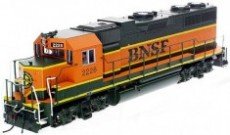Everything on model trains, model railroads, model railways, locomotives, model train layouts, scenery, wiring, DCC and more. Enjoy the world's best hobby... model railroading!
Clever Idea To Avoid Damage To Trains Derailing (and a question)
John sent in this helpful suggestion and also has a question he is hoping someone can answer for him:
We know that 4×8′ (HO) and 2×4′ (N) tables are basics for smaller model train layouts, as most tables and plywood come in 2×8′ and 2×4′ sizes. This size is a good starting point for beginners, and many of today’s great modelers started and learned with smaller layouts. But there is one problem.
Using N-Scale as an example, the 2×4′ table is great if you use 9-3/4″ radius curves in making a basic oval, but trouble arises when you try to make a two-train set-up using 11″ curves outside the 9-3/4″ loop. The larger curved radius brings the track right to the edge of the table, leaving the train where it could easily fall or be knocked onto the floor. But a way around this does exist, as the outside of the train board can be increased an inch or so on each side. The outer track would then stay on the solid board, while the added edges can be used for scenery such as rocks, trees, lichen, or building flats.
Many possibilities can be used to make these edges, such as wood, extruded insulation board, or plastic. There is one substance that I’m not able to remember the name – it’s something like pipe-wrap with an opening all along one end, but is plastic and a lot sturdier. I believe this material is used on trim wood for paneling. Does someone know the name of this product please?
G Scale SF Cable Car
Richard has a question for anyone with knowledge of G scale and asks:
“I am currently building a G-scale SF cable car from Occre. Would anyone happen to know where I could buy a pair of circular beacon lights for the opposite front panels of this model. Diameter would be .25 inch. Voltage should be 6-12v. DC. I also would like to install 4 overhead lamps to hang from the underside of the roof of the cable car, same voltage, diameter to be 3/16 inch. Color of these lights is clear. Finally, there are 4 pilot lights that need to be installed in the 4 corners of the roof top of the model. Color is yellow, voltage 6-12v. Diameter would be. 1/8 inch.”
Add your suggestion below.
HO P2K Refits
Bruce has a question for those in the hobby who know something about HO P2K refits:
“After many years of not modeling, I have acquired a large number of P2K new in-box engines that I would like to update with sound and as I have heard of many problems with P2K from the early 2000s, it would appear that motor issues are also to be dealt with. Can the P2K shells be used with newer Athearn, Atlas or P2K sound power units? I have a total of 25 units.”
No Power To The Track
Gil wants advice from others in the hobby and asks:
“I laid my track, and it all ran smoothly. I wired up points – OK – all tested prior to Ballast – when dry went to test with Loco – guess what no power to track. I thought I would remove the Ballast from areas of the power contact, but still no go. Any thoughts would be appreciated.”
Add your thoughts.
TOMIX 6421 Track Cleaning Car
Peter asks readers:
“I hope someone can help me. I have acquired a TOMIX 6421 Track Cleaning Car. Unfortunately the instruction leaflet is in Japanese. Where could I obtain English instructions so that I can use it to clean my tracks. I have tried a number of sources but no-one can offer any positive help.”
HO Scale Roadbed Adhesives
Ed seeks advice from others in the hobby and asks:
“I am using the foam method for my base. What is the best glue to hold down the cork roadbed on the foam backing and what about removal for changes later?”
Add your answer to this post.
No 1 Scale Garden Layout
Hans has a question for garden railway enthusiasts:
“I would like to know where I can get no 1 scale locomotives and rolling stock, and rails for an garden layout. I would prefer MARKLIN, but any a others with the detail of MARKLIN would also be acceptable.”
Paper and Plaster Scenery Construction
Ron has this question for others in the hobby:
“I am getting ready for some scenery on the layout. I was going to use paper wads under plaster cloth but a recent article said that the paper might absorb moister over time. What can I use other than paper?”
Add your answer below.
Derailment Issues Sorted
Fred sent in this suggestion:
“It seems I Hopefully corrected my derailment issues if any old school guys out there are still using the old style track. My one suggestion is to use ceiling tiles so you can push the nails down with a flathead screwdriver and also secure your joiners snugly to prevent derailments using flex track your best bet is to use it on long stretches of plywood layouts so that way there are two chances for derailments a slim one and poor on.”
OO Bachmann Class 66 Derailment
Wayne is hoping for some assistance from others in the hobby and asks:
“I recently bought a Bachmann DCC Class 66 and it seems to derail at any opportunity even on a straight run. I have Googled it and found it to be a common problem but cant find any solutions. Has anyone has same problem or know the solution? Thank you.”
Add your suggestion below.
HO Loco Control DCC and Non-DCC
Werner asks others for advice:
“Being a novice, I would like to know exactly what options I have with my layout. I have both DCC locomotives as well as non-DCC. I am planning to split my track (separate control) and run non-DCC on one circuit and DCC on the other. My experience being limited, I have read where the DCC loco can go onto non-DCC track but not vica-versa. Also it can’t run indefinitely on the DCC side. Any and all info on this subject is appreciated.”
Add your suggestions below.
HO DCC Decoders
Malcolm asks others for help:
“I am about to change to DCC. I am reading up on it but cannot see an answer to this question. If I want sound do I have to instal 2 decoders or does a sound decoder also perform like a basic decoder to operate the loco?”
Comment below.
Sn3 Telephone Pole Insulators
Paul wants advice from others and asks:
“I have one telephone pole in S scale that I got in a box of misc. stuff at a train show. It has clear insulators that look EXACTLY like phone pole insulators. I would like to know if anyone might know where I can find more of these type of insulators. No beads please. Like I said, the six clear insulators on the one pole that I have look just like the old time insulators, so I know that they are out there somewhere.”
Weathering a Shed the Inexpensive Way
John kindly contributed this article for publication:
 An old structure, a paper plate with water in it, a paint brush, and some black paint are all you need for this short and easy project. I used a very inexpensive N-Scale Imex Maintenance Shed (built-up), but you can use any structure that you don’t know what to do with. The shed comes in dark red with a dark gray roof, and all you have to do is dilute the black paint so that it slightly “puddles” on the structure where dirt and grime caused by years of use (as well as passing engines) would form on the walls and roof. Start with the roof and work down with the diluted black paint, and let it all dry when you’ve “weathered” it enough.
An old structure, a paper plate with water in it, a paint brush, and some black paint are all you need for this short and easy project. I used a very inexpensive N-Scale Imex Maintenance Shed (built-up), but you can use any structure that you don’t know what to do with. The shed comes in dark red with a dark gray roof, and all you have to do is dilute the black paint so that it slightly “puddles” on the structure where dirt and grime caused by years of use (as well as passing engines) would form on the walls and roof. Start with the roof and work down with the diluted black paint, and let it all dry when you’ve “weathered” it enough.
One thing about this structure – by itself, when the black paint dries, it looks bad enough to throw in the garbage and start on something else, or else put a coat of new paint on it instead of weathering. But put in on an old sidetrack on your layout, surround it with trees and weeds, and it looks fantastic! It’s really hard to beat a weathered structure, freight car, or locomotive!
Another way to inexpensively fill out a layout is to make your own signs using your computer and a printer. This gives you a choice of fonts, colors, and sizes. The paper to be used is heavyweight white sheets, available at office supply stores. Full-size (8-1/2 x 11″) paper with backing on it that gets peeled off is also ideal for signs on store-fronts, as it’s put on carefully and then pressed in so the adhesive on the back sticks to the structure. Remember to always work in your scale and don’t make the signs too big or so small that one has to use a magnifying glass to see what it says.
As with the Raccoon Lodge sign on the shed, I’m about 3/4 of the way making a small 2×3 in N-
Scale. The layout will be based on the old TV show The Honeymooners starring Jackie Gleason, who always had a lot to say. To make signs of his sayings that are not attached to buildings, I use wooden barbecue skewers to mount the sign in whatever height is needed. Seems to work pretty good, but not as good as the show itself, which will never be outdated!
Good Railroading!















